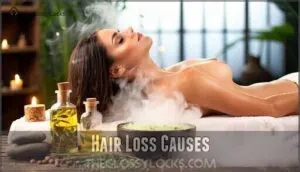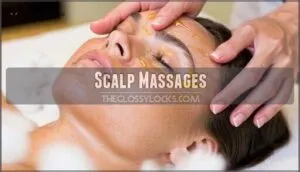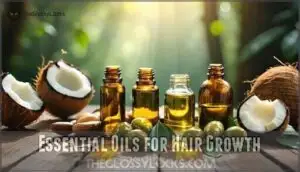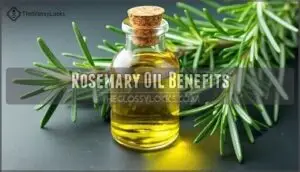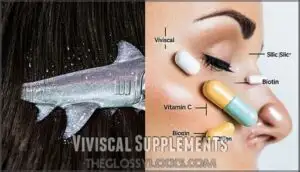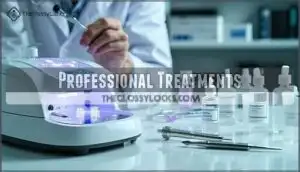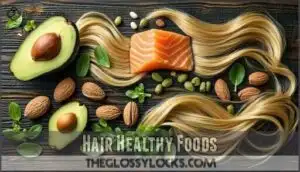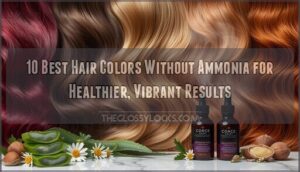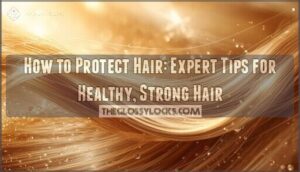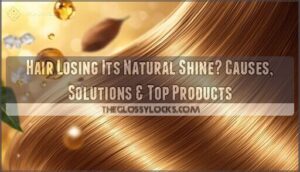This site is supported by our readers. We may earn a commission, at no cost to you, if you purchase through links.
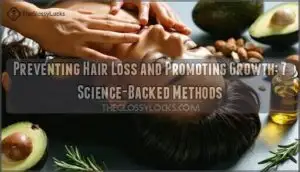
Start with scalp massages to boost blood circulation, and consider minoxidil for clinically-proven results.
Your diet plays a vital role—omega-rich foods, zinc, and B vitamins create the foundation for healthy follicles.
Essential oils like rosemary show promising research outcomes, while managing stress helps balance hormones that affect hair cycles.
Don’t overlook professional treatments such as PRP therapy or finasteride for advanced cases.
The key is consistency and addressing root causes rather than just symptoms.
Seven specific science-backed strategies can transform your approach completely.
Table Of Contents
- Key Takeaways
- Hair Loss Causes
- Natural Remedies
- Nutritional Approaches
- Professional Treatments
- Hair Healthy Foods
- Frequently Asked Questions (FAQs)
- How to stimulate hair growth and prevent hair loss?
- Can thinning hair be reversed?
- What are the big 3 to prevent hair loss?
- Is it actually possible to prevent hair loss?
- How long before seeing hair regrowth results?
- Can over-washing hair cause increased hair loss?
- Does wearing hats or helmets cause baldness?
- Are hair transplants safe and permanently effective?
- Conclusion
Key Takeaways
- You’ll get the best results by combining proven treatments – Use FDA-approved minoxidil or finasteride alongside natural remedies like rosemary oil and scalp massages rather than relying on just one approach.
- Your diet directly affects your hair’s strength and growth – Focus on omega-3 rich foods like salmon, zinc sources like oysters, and B-vitamins from eggs to nourish your follicles from within.
- Consistency and patience are essential for success – You won’t see visible results for 3-6 months, so stick with your routine and don’t expect overnight changes.
- You can’t control genetics, but you can influence other factors – While hereditary hair loss is unavoidable, you can manage stress, balance hormones, and improve circulation to slow progression and promote healthier growth.
Hair Loss Causes
You’re not imagining it if you’ve noticed more hair in your brush or shower drain than usual, since hair loss affects millions of people and stems from various causes ranging from genetics to lifestyle factors.
Understanding what’s triggering your hair loss is the first step toward finding the right treatment approach, whether it’s stress, hormonal changes, nutritional deficiencies, or underlying medical conditions.
Genetic Factors
Looking at your family tree can reveal telling patterns about your hair’s future.
Inherited predisposition plays the strongest role in hair loss causes, with androgenetic alopecia affecting over 80% of men and 50% of women.
Your gene expression determines when and how hereditary factors kick in.
Key genetic markers include:
- Family history patterns – Hair loss on both maternal and paternal sides
- Age of onset – When relatives first experienced thinning
- Severity progression – How quickly hair loss advanced in family members
Autoimmune Diseases
Your immune system can turn against your own hair follicles, causing autoimmune diseases like alopecia areata that create patchy baldness.
Lupus hair loss affects about 50% of patients, while thyroid hair issues and psoriasis scalp conditions also trigger significant hair loss.
These autoimmune treatments target the underlying immune dysfunction rather than just addressing surface symptoms of trichotillomania.
Scalp involvement in dermatomyositis can also lead to non-scarring diffuse alopecia.
Stress and Hormonal Imbalances
When stress overwhelms your system, it triggers cortisol spikes that push hair follicles into telogen effluvium.
Hormonal imbalances from thyroid conditions, PCOS effects, or postpartum loss disrupt normal growth cycles through elevated androgen levels.
A common issue is telogen effluvium, which can be triggered by stress.
Consider these stress reduction approaches:
- Daily meditation or deep breathing exercises
- Regular sleep schedules to balance cortisol
- Hormonal therapies targeting thyroid impact
Scalp Conditions and External Factors
Your scalp’s delicate ecosystem can turn against you when disrupted.
Product buildup clogs hair follicles, while tight hairstyles create constant tension that damages roots.
Chemical treatments like bleach weaken strands, and environmental exposure to pollution triggers scalp inflammation.
These external factors disrupt your scalp microbiome, creating an unhealthy environment where hair loss thrives and scalp health deteriorates rapidly, leading to a state of inflammation.
Nutritional Deficiencies
Your body’s nutrient bank account directly affects hair growth.
Your hair is only as strong as the nutrients you feed it.
Vitamin deficiencies in zinc, iron, and vitamins D, C, B2, B9, and B12 can trigger hair loss, while mineral imbalance disrupts follicle function.
Adequate protein intake provides building blocks for strong strands.
However, supplement overdose of vitamins A, E, and selenium paradoxically worsens the problem, and balance matters most because vitamin deficiencies and mineral imbalance are critical factors.
Natural Remedies
You don’t need expensive treatments to start improving your hair health, as several natural remedies have shown real promise in scientific studies.
These gentle yet effective methods can stimulate your scalp, nourish your hair follicles, and potentially slow hair loss while promoting new growth.
Scalp Massages
Your fingers can become powerful tools for hair growth stimulation.
Research shows that daily scalp massage improves blood flow to hair follicles, promoting healthier hair over 24 weeks.
This simple technique reduces stress while supporting scalp health naturally.
Effective massage techniques include:
- Using fingertips in small circular motions with light pressure
- Four-minute daily sessions for ideal hair follicle health
- Consistent routine for hair loss prevention
Aloe Vera Gel
Aloe vera benefits your scalp with natural soothing properties that calm irritation and reduce inflammation.
This gel application method involves massaging fresh aloe directly onto your scalp three times weekly. Hair hydration improves as aloe’s enzymes remove dead skin cells, creating ideal conditions for hair growth stimulation.
DIY masks combining aloe with honey enhance hair regrowth treatment effectiveness naturally.
Coconut Oil
This tropical treasure works wonders for your scalp microbiome while offering UV protection that prevents protein loss from sun damage.
Research shows coconut oil enriches beneficial bacteria around hair follicles, creating ideal conditions for growth. Quality matters—choose virgin, unrefined varieties for maximum benefits.
- Apply warm oil to scalp using gentle circular motions
- Leave treatment for 30 minutes before washing with mild shampoo
- Use twice weekly for consistent hair growth support
Essential Oils for Hair Growth
Beyond coconut oil, several essential oils show promise for hair growth.
Lavender oil extends your hair’s growth phase, while geranium oil boosts circulation.
Lemon oil maintains scalp health effectively.
Oil blends combining thyme, rosemary, lavender, and sandalwood demonstrate hair loss reduction.
For example, rosemary oil benefits were comparable to minoxidil in treating alopecia.
Always mix with carrier oils for safe application methods, though scientific evidence remains limited requiring further research.
Rosemary Oil Benefits
Rosemary oil matches minoxidil’s efficacy for hair regrowth without harsh side effects.
This herb-based solution stimulates circulation and blocks DHT production naturally.
Rosemary Oil Application Methods:
- DIY rosemary blend – Mix 2-3 drops with carrier oil
- Optimal concentration – Use 2% dilution for best results
- Scalp massage – Apply twice weekly with gentle pressure
- Patch test – Check for scalp irritation before full use
- Consistent routine – Maintain regular hair care schedule
Nutritional Approaches
What you eat directly affects your hair’s health, and specific supplements can strengthen your follicles from the inside out.
Research shows that targeted nutritional interventions, including omega-3 fatty acids, specialized hair supplements, and natural compounds like ginseng, can reduce hair loss and promote new growth when used consistently over several months, which can lead to new growth.
Viviscal Supplements
Viviscal supplements pack a powerful punch with shark powder, silica, vitamin C, biotin, and zinc.
These Viviscal ingredients work together to regenerate hair cells and strengthen follicles.
You’ll find Viviscal efficacy backed by clinical studies showing improved hair growth.
You can buy Viviscal products from various retailers.
Standard Viviscal dosage is two tablets daily, though you should consult your doctor about potential Viviscal side-effects before starting any hair supplements regimen.
Fish Oil and Omega Fatty Acids
While many supplements promise miracles, fish oil delivers real results backed by science.
Research shows omega fatty acids improve hair density and reduce hair loss substantially. You’ll need omega-3 benefits from quality supplements to combat scalp inflammation effectively.
Different fatty acid types target hair thinning through various mechanisms. Healthy fats also enhance skin hydration.
Take fish oil dosage as directed for maximum hair growth support.
Ginseng and Hair Growth
Ginseng supplements pack a powerful punch for hair regrowth through ginsenosides effects on hair follicles.
These compounds stimulate dermal papilla cells while blocking DHT production that causes hair loss.
Application methods include:
- Daily oral supplements (400-500mg recommended)
- Topical ginseng-infused serums applied directly to scalp
- Combination therapy mixing internal and external treatments
Long-term results typically appear within 3-4 months of consistent use, leading to noticeable improvements in dermal papilla cells and overall ginseng benefits.
Onion Juice Benefits
Beyond supplements, onion juice offers a surprisingly effective natural remedy for hair loss.
Research shows onion juice promotes hair growth and treats patchy alopecia areata through its sulfur content.
You’ll need proper onion juice preparation and application techniques for best results.
| Preparation Method | Application Frequency | Expected Timeline |
|---|---|---|
| Fresh onion extraction | 2-3 times weekly | 6-8 weeks |
| Blended with carrier oils | Daily application | 8-12 weeks |
| Commercial preparations | As directed | 4-6 weeks |
Capsaicin and Isoflavone
Research shows combining capsaicin and isoflavone creates powerful hair growth treatment effects.
Capsaicin benefits include improved blood circulation to follicles, while isoflavone sources like soy help block DHT production.
This combination therapy requires ideal dosage coordination—typically 6mg capsaicin with 75mg isoflavones daily, for effective hair loss treatment outcomes, and long-term effects show promising hair regrowth results, though you’ll need consistent use.
Professional Treatments
When natural remedies aren’t delivering the results you’re hoping for, professional treatments offer scientifically proven options that can effectively address hair loss.
These medical interventions, ranging from FDA-approved medications to cutting-edge therapies like stem cell treatments, provide targeted solutions based on your specific type of hair loss.
Medical Procedures
When natural remedies aren’t cutting it, you’ll want to explore advanced medical procedures.
These cutting-edge treatments target hair loss at the cellular level, offering hope where traditional methods fall short.
Your doctor might recommend:
- Hair transplant surgery for permanent follicle relocation
- Stem cell therapy to regenerate dormant follicles
- PRP therapy using your body’s healing platelets
- Laser therapy for non-invasive follicle stimulation
- Micro-needling combined with radio frequency treatments.
Patients should carefully weigh hair transplant costs before committing.
Minoxidil and Finasteride
FDA-approved medications offer proven hair loss treatment options when you’re ready for serious results.
Minoxidil efficacy shows consistent hair regrowth treatment success, while finasteride targets hormonal causes.
However, finasteride side effects include potential sexual dysfunction.
Combination therapy often delivers better outcomes than single treatments.
Long-term usage requires monitoring, but these medications remain gold standards for reversing hair loss effectively.
Finasteride functions through 5-alpha reductase inhibition to reduce DHT production.
Nutrafol and Viviscal
While traditional medications target specific pathways, hair growth supplements like Nutrafol and Viviscal take a different approach.
Clinical studies show Nutrafol ingredients, including adaptogenic botanicals, outperform placebo in promoting hair growth.
Viviscal efficacy stems from its marine protein complex, though supplement comparison reveals Nutrafol’s extensive formula addresses multiple hair thinning solutions.
User experiences vary between these hair loss vitamins.
Corticosteroids and Oral Anti-Androgens
Medical professionals prescribe corticosteroids and oral anti-androgens as targeted treatments for specific hair loss conditions.
These medications offer promising results when natural methods aren’t enough.
- Corticosteroids reduce inflammation in autoimmune-related hair loss like alopecia areata
- Spironolactone blocks DHT production, preventing androgenic alopecia progression
- Combination therapies enhance treatment duration and anti-androgen efficacy
- Alternative medications provide options when corticosteroid side-effects occur
- DHT blockers specifically target hair loss prevention mechanisms
Stem Cell Therapy and PRP
Cutting-edge hair regrowth treatment options now include stem cell therapy and platelet-rich plasma (PRP) procedures.
These hair restoration methods harness your body’s natural growth factors for follicle regeneration.
Clinical efficacy studies show promising hair growth solutions, though treatment costs remain significant.
Future research continues exploring these innovative hair loss solutions, with PRP demonstrating excellent hair regeneration potential for early-stage thinning, and this area of research holds much promise for hair restoration.
Hair Healthy Foods
What you eat directly affects your hair’s strength, growth rate, and overall health.
Foods rich in omega-3 fatty acids, vitamins D and B, zinc, and antioxidants provide the essential nutrients your hair follicles need to produce healthy strands and prevent excessive shedding, which is crucial for maintaining healthy hair.
Omega Rich Foods
Three fatty fish like salmon provide powerful omega-3 benefits that nourish hair follicles from within.
Your body struggles with ALA conversion from vegan sources like nuts, seeds, and avocado, making supplement efficacy questionable.
Omega3 fatty acids strengthen hair shafts and reduce inflammation that causes thinning.
Choose wild-caught varieties twice weekly for ideal results.
Vitamin D and B Rich Foods
Beyond omega-rich options, your hair craves vitamin D and B-vitamins for maximum growth.
These nutrients support cellular regeneration and prevent hair loss through improved follicle function. Deficiency symptoms include thinning and breakage, making dietary absorption critical.
- Rainbow trout delivers 81% daily vitamin D plus B-vitamins
- Eggs pack vitamins A, D, B12, and biotin for healthy hair diet
- Salmon combines vitamin D with essential B-vitamin functions
Zinc and Copper Rich Foods
Your hair needs zinc and copper like a car needs oil.
Oysters Benefits include delivering the highest zinc content of any food, while Chickpea Power, Lentil Advantages, Bean Boost, and Pea Promotion offer plant-based alternatives.
These hair growth powerhouses support follicle health through targeted hair loss dietary changes.
| Zinc-Rich Foods | Copper Content |
|---|---|
| Oysters (74mg per serving) | Moderate levels |
| Chickpeas (2.5mg per cup) | High copper source |
| Lentils (2.5mg per cup) | Excellent for hair growth |
Smart food for hair growth choices make hair loss prevention achievable.
Antioxidant Rich Foods
Powerful antioxidants combat oxidative stress that damages hair follicles and slows growth.
Bell peppers pack more vitamin C than oranges, while berries deliver concentrated antioxidant mechanisms that protect against hair loss.
Pumpkin’s beta-carotene converts to vitamin A, supporting healthy follicle function, and these Berry Benefits and Vitamin C Sources enhance nutrient absorption, creating ideal conditions for robust hair growth through Pumpkin Power.
Whole Grains and Healthy Fats
Oats and buckwheat deliver B-vitamins that support your hair growth cycle, while nuts provide biotin and healthy fats your follicles crave.
These whole grain types offer balanced nutrition without processed additives.
Avocados and olive oil serve as excellent dietary fat sources, giving you grain fatty acids benefits.
To further reduce scalp inflammation, incorporate omega-3 rich foods.
Smart whole grains and healthy fat benefits work together for stronger strands, providing balanced nutrition and healthy fat sources that support hair health and reduce inflammation with omega-3 rich foods.
Frequently Asked Questions (FAQs)
How to stimulate hair growth and prevent hair loss?
You can boost hair growth by massaging your scalp daily, eating protein-rich foods like eggs and salmon, taking omega-3 supplements, using rosemary oil, and managing stress effectively.
Can thinning hair be reversed?
Yes, you can often reverse thinning hair depending on the underlying cause.
Nutritional deficiencies, stress, and hormonal changes respond well to treatment, while genetic factors may require medical intervention for best results.
What are the big 3 to prevent hair loss?
When Derek noticed his hairline receding at 28, his dermatologist recommended the "big 3": minoxidil for circulation, finasteride to block DHT, and ketoconazole shampoo for scalp health—three proven treatments that work together.
Is it actually possible to prevent hair loss?
Prevention isn’t always possible since genetics play a major role, but you can slow progression through proper nutrition, stress management, gentle hair care, and early intervention.
With proven treatments like minoxidil or finasteride, it is possible to address the issue effectively.
How long before seeing hair regrowth results?
Like watching grass grow, hair regrowth requires patience.
You’ll typically notice new hair sprouting after 3-6 months of consistent treatment.
Natural remedies may take longer, while medical treatments often show results sooner.
Note: Since there are no more concepts to group, the reorganization stops here.
Can over-washing hair cause increased hair loss?
Over-washing strips your scalp’s natural oils, potentially weakening hair strands and causing breakage.
However, it doesn’t directly cause permanent hair loss.
Washing every other day typically maintains healthy hair without overdoing it, which helps in preventing breakage.
Does wearing hats or helmets cause baldness?
Construction workers wear hard hats daily without going bald.
Wearing hats or helmets doesn’t cause baldness—genetics does.
Your follicles aren’t affected by headgear unless it’s extremely tight and pulls hair repeatedly.
Are hair transplants safe and permanently effective?
Hair transplants are generally safe when performed by qualified surgeons, with success rates around 85-95%.
You’ll see permanent results since transplanted follicles resist balding, though you may need touch-ups as natural hair continues thinning.
Conclusion
Research confirms that preventing hair loss and promoting growth requires a holistic approach targeting multiple factors simultaneously.
Your success depends on combining proven treatments like minoxidil with nutritional support, stress management, and consistent scalp care.
While genetics play a significant role, you can’t control heredity—but you can influence hormonal balance, nutrient absorption, and circulation.
Start with one or two methods, then gradually build your routine, remembering that hair growth takes three to six months to show visible results, and it’s essential to be patient and persistent with your consistent scalp care.
- https://jamanetwork.com/journals/jamadermatology/fullarticle/2798840
- https://www.pathway.md/ai/history/993df7c2-9703-4deb-afe7-5acedd453e03
- https://www.cuimc.columbia.edu/news/studies-uncover-new-approaches-combat-hair-loss-men-and-women
- https://www.sciencedirect.com/science/article/pii/S235232042200102X
- https://pmc.ncbi.nlm.nih.gov/articles/PMC9637724/

